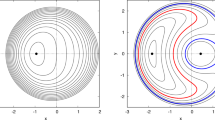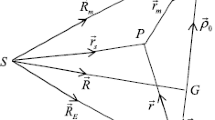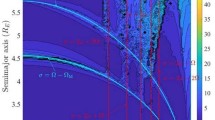Abstract
Lunisolar resonances arise in the artificial satellite problem without short-periodic terms. The basic model including the Earth’s J 2 and a Hill-type model for the Sun or the Moon admits 20 different periodic terms which may lead to a resonance involving the satellite’s perigee, node and the longitude of the perturbing body. Some of the resonances have been studied separately since 1960s. The present paper reviews all single resonances, attaching an appropriate fundamental model to each case. Only a part of resonances match known fundamental models. An extended fundamental model is proposed to account for some complicated phenomena. Most of the double resonance cases still remain unexplored.
Access this chapter
Tax calculation will be finalised at checkout
Purchases are for personal use only
Preview
Unable to display preview. Download preview PDF.
Similar content being viewed by others
References
Andoyer, H.: 1903, ‘Contribution à la théorie des petites planétes dont le moyen mouvement est sensiblement double de celui de Jupiter’, Bull. Astron. 20, 321–356.
Beaugé, C.: 1994, ‘Asymmetric librations in exterior resonances’, Celest. Mech. and Dyn. Astr. 60, 225–248.
Breiter, S.: 1999, ‘lunisolar apsidal resonances at low satellite orbits’, Celest. Mech. and Dyn. Astr. 74, 253–274.
Breiter, S.: 2000, ‘The prograde C7 resonance for Earth and Mars satellite orbits’, Celest. Mech. and Dyn. Astr. 77, 201–214.
Breiter, S.: 2001, ‘On the coupling of lunisolar resonances for Earth satellite orbits’, Celest. Mech. and Dyn. Astr. 80, 1–20.
Brouwer, D.: 1959, ‘Solution of the problem of artificial satellite theory without drag’, Astron. J. 64, 378–397.
Coffey, S. L., Deprit, A. and Deprit, E.: 1994, ‘Frozen orbits for satellites close to an Earth-like planet’, Celest. Mech. and Dyn. Astr. 59, 37–72.
Cook, G. E.: 1962, ‘Luni-solar perturbations of the orbit of an Earth satellite’, Geophys. J. 6, 271–291.
Henrard, J. and Lemaitre, A.: 1983, ‘A second fundamental model for resonance’, Celest. Mech. 30, 197–218.
Hough, M. E.: 1981a, ‘Orbits near critical inclination, including lunisolar perturbations’, Celest. Mech. 25, 111–136.
Hough, M. E.: 198 lb, ‘Sun-synchronous orbits near critical inclination’, Celest. Mech. 25, 137–157.
Hughes, S.: 1980, ‘Earth satellite orbits with resonant lunisolar perturbations, I. Resonances dependent only on inclination’, Proc. R. Soc. Lond. A 372, 243–264.
Hughes, S.: 1981, ‘Earth satellite orbits with resonant lunisolar perturbations, II. Some resonances dependent on the semi-major axis, eccentricity and inclination’, Proc. R. Soc. Lond. A 375, 379–396.
James, J.: 1993, The Music of the Spheres, Grove Press, New York.
Kozai, Y.: 1962, ‘Secular perturbations of asteroids with high inclination and eccentricity’, Astron. J. 67, 591–598.
Kudielka, V.: 1997, ‘Equilibria bifurcations of satellite orbits’, In: R. Dvorak and J. Henrard (eds), The Dynamical Behaviour of our Planetary System, Kluwer, pp. 243–255.
Lidov, M. L.: 1961, ‘Evolution of artificial planetary satellites under the action of gravitational perturbations due to external bodies’, Isskustvennye Sputniki Zemli (in Russian) 8, 5–45.
Lemaitre, A.: 1984, ‘High-order resonances in the restricted three-body problem’, Celest. Mech. and Dyn. Astr. 32, 109–126.
Musen, P.: 1960, ‘Contributions to the theory of satellite orbits’, In: H. K. Bijl (ed.), Space Research, North-Holland, New York, pp. 434–447.
Author information
Authors and Affiliations
Editor information
Editors and Affiliations
Rights and permissions
Copyright information
© 2001 Springer Science+Business Media Dordrecht
About this paper
Cite this paper
Breiter, S. (2001). Lunisolar Resonances Revisited. In: Pretka-Ziomek, H., Wnuk, E., Seidelmann, P.K., Richardson, D.L. (eds) Dynamics of Natural and Artificial Celestial Bodies. Springer, Dordrecht. https://doi.org/10.1007/978-94-017-1327-6_10
Download citation
DOI: https://doi.org/10.1007/978-94-017-1327-6_10
Publisher Name: Springer, Dordrecht
Print ISBN: 978-90-481-5865-2
Online ISBN: 978-94-017-1327-6
eBook Packages: Springer Book Archive




